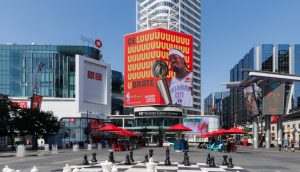
This article originally appeared in strategy’s Winter 2022 issue
By Eoin Weldon
What’s the first image to enter your mind when you hear the word “hologram”? Something futuristic no doubt. The eye-rubbing sight of deceased rapper Tupac Shakur resurrected for a surprise performance at Coachella in 2012? Or perhaps hypnotic blue floating figures in the Star Wars franchise?
That undeniable hypnotism is why the advertising and marketing industries have flirted with holographic displays for the last two decades. At one point they were the “next big thing” for brands to communicate with consumers, yet mysteriously they never fully caught on. Holograms disappeared as quickly as they appeared. However, they seem to be making a comeback, with a handful of companies experimenting with the 3D format over the past couple months.
Using PORTL’s holographic technology, Johnnie Walker, for example, gave its products the holographic treatment in LCBO stores to educate and engage with shoppers. Toronto’s Eaton Centre and retail giant Nordstrom used the unique technology inside their malls and stores in early December to help people “shop the look” for the holiday season. Loblaws also got in on the action by installing holographic displays in some of its stores to mark the return of its PC Insiders Report magazine.
Lance So, customer marketing manager at Diageo, told strategy that Johnnie Walker chose the tech for its ability to educate consumers around tasting notes and holiday cocktails, creating intimate one-to-one interactions with customers without physically being face-to-face, making it pandemic-friendly.

Meanwhile, Meghan Nameth, SVP of marketing, says Loblaws installed holographic displays of a chef talking about the inspiration they can find in the Report, alongside the benefits of its new products. “Our customers are open to digital marketing and communications, which is why we are incorporating new trending technologies like holograms into our marketing campaigns,” says Nameth.
The rise in digital signage over the last few years could make the comeback for holographic displays a successful one, particularly as the pandemic continues to force marketers to choose media channels that can quickly respond to changing conditions. The global digital signage market was valued at CAD$28.3 billion in October of 2021 and is expected to be worth just shy of CAD$50 billion by 2030.
Technology expert and founder of Six Pixels Group, Mitch Joel gave his opinion on the reemergence of holographic displays in marketing. Being a technology purist Joel doesn’t view the displays by Johnny Walker, Loblaws and the like as true holograms. He sees them as a mixture of augmented reality (AR) and “cool parlour tricks,” but does appreciate and laud their usefulness as a marketing tool.
“What are brands ultimately trying to do here? They are trying to generate attention,” says Joel. “So anything that looks bright and three-dimensional is very engaging and captivating.”
“These displays get companies a lot of PR at the end of the day so anything we see that gives a company an edge is always popular and technology is great for that. We’ve had more amplification through COVID of the fact that these digital tools exist and have been innovated on. So should we be surprised that we’re seeing a resurgence of technology from the past? No.”
As for the future of holographic displays, Joel says he believes in “a screenless future, one where projections and our access to information won’t be based off of me pulling something out of my pocket or looking at my watch or laptop. I foresee projections and access to technology and holograms being everywhere.”

With files from Chris Lombardo























